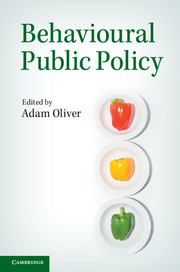Book contents
- Frontmatter
- Contents
- List of Figures
- List of Tables
- List of Contributors
- Introduction
- 1 Ambiguity aversion and the UK government’s response to swine flu
- 2 Models of governance of public services: empirical and behavioural analysis of ‘econs’ and ‘humans’
- 3 From irresponsible knaves to responsible knights for just 5p: behavioural public policy and the environment
- 4 The more who die, the less we care: psychic numbing and genocide
- 5 Healthy habits: some thoughts on the role of public policy in healthful eating and exercise under limited rationality
- 6 Confessing one’s sins but still committing them: transparency and the failure of disclosure
- 7 How should people be rewarded for their work?
- 8 Influencing the financial behaviour of individuals: the mindspace way
- 9 Decision analysis from a neo-Calvinist point of view
- Index
- References
8 - Influencing the financial behaviour of individuals: the mindspace way
Published online by Cambridge University Press: 05 June 2014
- Frontmatter
- Contents
- List of Figures
- List of Tables
- List of Contributors
- Introduction
- 1 Ambiguity aversion and the UK government’s response to swine flu
- 2 Models of governance of public services: empirical and behavioural analysis of ‘econs’ and ‘humans’
- 3 From irresponsible knaves to responsible knights for just 5p: behavioural public policy and the environment
- 4 The more who die, the less we care: psychic numbing and genocide
- 5 Healthy habits: some thoughts on the role of public policy in healthful eating and exercise under limited rationality
- 6 Confessing one’s sins but still committing them: transparency and the failure of disclosure
- 7 How should people be rewarded for their work?
- 8 Influencing the financial behaviour of individuals: the mindspace way
- 9 Decision analysis from a neo-Calvinist point of view
- Index
- References
Summary
Introduction
The question of how to improve population-wide financial capability is of increasing concern to policy-makers. This chapter is focused on how recent advances in behavioural economics can help us better understand financial decision-making and, ultimately, to design interventions that make it easier for us to behave in ways that improve our financial capability. Behavioural economics seeks to combine the lessons from psychology with the laws of economics (Kahneman, 2003). The basic insight of behavioural economics is that human behaviour is guided not by the dictates of rationality embodied in a super-computer that can analyse the costs and benefits of every action. Instead, it is led by our very human, sociable, emotional and sometimes fallible brain. Psychologists have been studying these characteristics for more than a century, and writers and thinkers for much longer (Triplett, 1898). In a nutshell, the mental shortcuts that serve us so well in much of life can also get us into trouble, both as individuals and as societies.
Consistent with these observations, two very general paradigms have emerged in recent years – models that aim to change cognitions (such as beliefs and attitudes), and models that change the context (environment or situation) within which the person acts. Most traditional interventions prompt changes in cognitions to bring about behaviour change (Webb and Sheeran, 2006). This may involve providing new information or changing the incentives. The presumption is that people will analyse the relevant pieces of information, the numerous incentives offered to them, and act in ways that reflect their best interests. In contrast, the second route relies mostly on contextual changes to bring about behaviour change, where the focus is on the more automatic processes of judgement and influence. The context model recognizes that people are sometimes seemingly irrational and inconsistent in their choices. As a result, it focuses more on changing behaviour without ‘changing minds’.
- Type
- Chapter
- Information
- Behavioural Public Policy , pp. 191 - 215Publisher: Cambridge University PressPrint publication year: 2013
References
- 5
- Cited by



